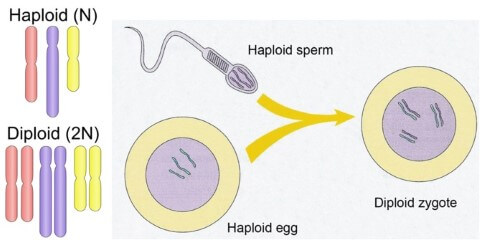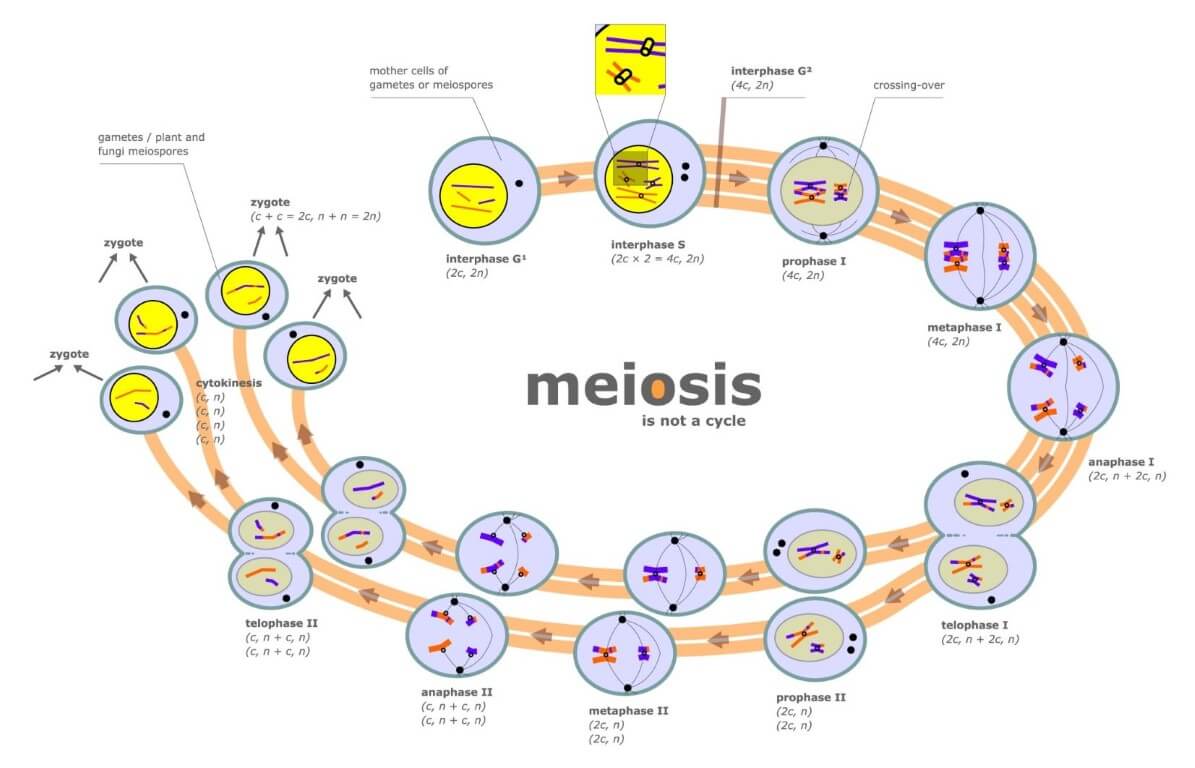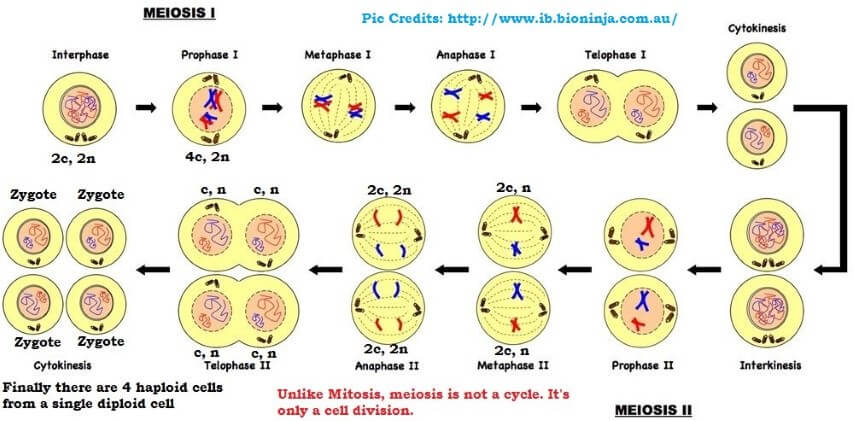Meiosis
- Meiosis is a specialized kind of cell division that reduces the chromosome number by half and results in the production of haploid daughter cells.
- The production of offspring by sexual reproduction includes the fusion of two gametes [sperm and ovum], each with a complete haploid set of chromosomes.
- These haploid gametes come into existence due to meiosis [meiosis type of cell division]. The gametes are formed from specialized diploid cells.
[Diploid == containing two complete sets of chromosomes, one from each parent].
[Haploid == only one set of chromosomes from one of the parent].
- Meiosis ensures the production of haploid phase in the life cycle of sexually reproducing organisms whereas fertilization restores the diploid phase.
Meiotic events can be grouped under the following phases
Meiosis I
Prophase I
- Prophase of the first meiotic division is typically longer and more complex when compared to prophase of mitosis.
- It has been further subdivided into the following five phases based on chromosomal behavior, i.e., Leptotene, Zygotene, Pachytene, Diplotene and Diakinesis.
Leptotene
- During leptotene stage the chromosomes become gradually visible under the light microscope.
- The compaction of chromosomes continues throughout leptotene.
Zygotene
- During this stage chromosomes start pairing together and this process of association is called synapsis.
- Such paired chromosomes are called homologous chromosomes.
- Chromosome synapsis is accompanied by the formation of complex structure called synaptonemal complex.
- The complex formed by a pair of synapsed homologous chromosomes is called a bivalent or a tetrad. However, these are more clearly visible at the next stage.
- The first two stages of prophase I are relatively short-lived compared to the next stage, that is pachytene.
Pachytene
- During this stage bivalent chromosomes now clearly appears as tetrads.
- This stage is characterized by the appearance of recombination nodules, the sites at which crossing over occurs between non-sister chromatids of the homologous chromosomes.
- Crossing over is the exchange of genetic material between two homologous chromosomes.
Pic Credits: http://www.ib.bioninja.com.au/_Media/chiasma_med.jpeg
- Crossing over is an enzyme-mediated process and the enzyme involved is called recombinase.
- Crossing over leads to recombination [exchange] of genetic material on the two chromosomes.
- Recombination between homologous chromosomes is completed by the end of pachytene, leaving the chromosomes linked at the sites of crossing over.
Diplotene
- The beginning of diplotene is recognized by the dissolution of the synaptonemal complex and the tendency of the recombined homologous chromosomes of the bivalents to separate from each other except at the sites of crossovers.
- These X-shaped structures, are called chiasmata.
Diakinesis
- This is marked by terminalisation of chiasmata.
- During this phase the chromosomes are fully condensed and the meiotic spindle is assembled to prepare the homologous chromosomes for separation.
- By the end of diakinesis, the nucleolus disappears and the nuclear envelope also breaks down.
- Diakinesis represents transition to metaphase.
Metaphase I
- The bivalent chromosomes align on the equatorial plate. The microtubules from the opposite poles of the spindle attach to the pair of homologous chromosomes.
Anaphase I
- The homologous chromosomes separate, while sister chromatids remain associated at their centromeres.
Telophase I
- The nuclear membrane and nucleolus reappear, cytokinesis follows and this is called as diad of cells.
Interkinesis
- The stage between the two meiotic divisions is called interkinesis and is generally short lived.
- Interkinesis is followed by prophase II, a much simpler prophase than prophase I.
Pic Credits: Wikipedia
Meiosis II
Prophase II
- Meiosis II is initiated immediately after cytokinesis, usually before the chromosomes have fully elongated.
- In contrast to meiosis I, meiosis II resembles a normal mitosis.
- The nuclear membrane disappears by the end of prophase II. The chromosomes again become compact.
Metaphase II
- At this stage the chromosomes align at the equator and the microtubules from opposite poles of the spindle get attached to the kinetochores of sister chromatids.
Anaphase II
- It begins with the simultaneous splitting of the centromere of each chromosome (which was holding the sister chromatids together), allowing them to move toward opposite poles of the cell.
Telophase II
- Meiosis ends with telophase II, in which the two groups of chromosomes once again get enclosed by a nuclear envelope; cytokinesis follows resulting in the formation of tetrad of cellse., four haploid daughter cells.
Significance of Meiosis
- Meiosis is the mechanism by which conservation of specific chromosome number of each species is achieved across generations in sexually reproducing organisms, even though the process, per se, paradoxically, results in reduction of chromosome number by half.
- It also increases the genetic variability in the population of organisms from one generation to the next. Variations are very important for the process of evolution.
Mitosis – Meiosis Comparison
- Cell cycle is divided into two phases called (i) Interphase – a period of preparation for cell division, and (ii) Mitosis (M phase) – the actual period of cell division.
- Interphase is further subdivided into G1, S and G2.
- G1 phase is the period when the cell grows and carries out normal metabolism. Most of the organelle duplication also occurs during this phase.
- S phase marks the phase of DNA replication and chromosome duplication.
- G2 phase is the period of cytoplasmic growth.
- Mitosis is also divided into four stages namely prophase, metaphase, anaphase and telophase.
- Prophase == Chromosomes condense [chromatids to chromosomes], centrioles move to the opposite poles, nuclear envelope and the nucleolus disappear and the spindle fibres start appearing.
- Metaphase == alignment of chromosomes at the equatorial plate.
- Anaphase == centromeres divide, chromatids start moving towards the two opposite poles.
- Telophase == chromosomal elongation starts, nucleolus and the nuclear membrane reappear.
- Cytokinesis == cytoplasmic division.
- Mitosis thus, is the equational division in which the chromosome number of the parent is conserved in the daughter cell.
- In contrast to mitosis, meiosis occurs in the diploid cells, which are destined to form gametes.
- It is called the reduction division since it reduces the chromosome number by half while making the gametes.
- In sexual reproduction when the two gametes fuse the chromosome number is restored to the value in the parent.
- Meiosis is divided into two phases – meiosis I and meiosis II.
- In the first meiotic division the homologous chromosomes pair to form bivalents, and undergo crossing over.
- Meiosis I has a long prophase.
- Prophase I == leptotene, zygotene, pachytene, diplotene and diakinesis.
- Metaphase I == bivalents arrange on the equatorial plate.
- Anaphase I == homologous chromosomes move to the opposite poles with both their chromatids. Each pole receives half the chromosome number of the parent cell.
- Telophase I == nuclear membrane and nucleolus reappear.
Pic Credits: http://www.ib.bioninja.com.au/higher-level/topic-10-genetics/101-meiosis.html
- Meiosis II is similar to mitosis.
- During anaphase II the sister chromatids separate.
- Thus at the end of meiosis four haploid cells are formed.
Mitosis | Meiosis | |
| Number of divisions | One | Two – Meiosis I and Meiosis II. |
| DNA Replication | Occurs during interphase | Occurs during interphase |
| Role | Asexual cellular reproduction and cell repair. Produces only somatic cells. | Asexual cellular reproduction that produces gametes. |
| Type of cells that divide | In animals, mitotic cell division is only seen in the diploid somatic cells. But plants can show mitotic divisions in both haploid and diploid cells. | Meiotic cell division is seen only in diploid cells. |
| Cell Cycle | Both cell division and cell cycle. | It is only cell division and not cell cycle. |
| Daughter cells produced | Two diploid daughter cells (2n) that are genetically identical to the parent cell. | Four haploid daughter cells (n) containing half the number of chromosome as the parent cell. |








0 Comments